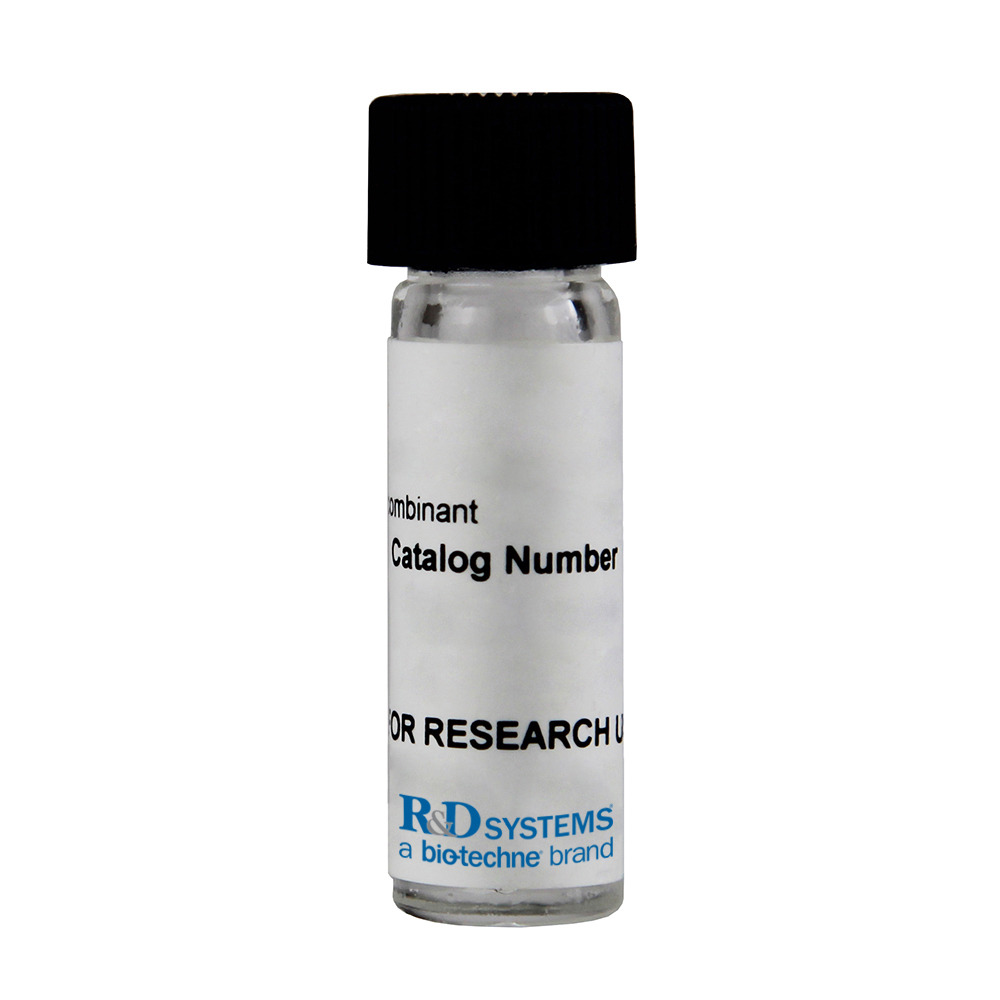

 下载产品说明书
下载产品说明书 下载SDS
下载SDS 用小程序,查商品更便捷
用小程序,查商品更便捷



 收藏
收藏
 对比
对比 咨询
咨询Carrier Free
CF stands for Carrier Free (CF). We typically add Bovine Serum Albumin (BSA) as a carrier protein to our recombinant proteins. Adding a carrier protein enhances protein stability, increases shelf-life, and allows the recombinant protein to be stored at a more dilute concentration. The carrier free version does not contain BSA.
In general, we advise purchasing the recombinant protein with BSA for use in cell or tissue culture, or as an ELISA standard. In contrast, the carrier free protein is recommended for applications, in which the presence of BSA could interfere.
8658-PK
| Formulation | Supplied as a 0.2 μm filtered solution in Tris, NaCl and DTT. |
| Shipping | The product is shipped with dry ice or equivalent. Upon receipt, store it immediately at the temperature recommended below. |
| Stability & Storage: | Use a manual defrost freezer and avoid repeated freeze-thaw cycles.
|
Recombinant Human Pyridoxal Kinase Protein, CF Summary
Product Specifications
Glu2-Leu312, with N-terminal Met and 6-His tag
Accession # O00764
Analysis

Background: Pyridoxal Kinase/PDXK
Pyridoxal Kinase (PDXK) phosphorylates vitamin B6, a step required for the conversion of vitamin B6 to pyridoxal-5-phosphate (PLP), an important cofactor in intermediary metabolism (1). PLP is involved in many aspects of macronutrient metabolism, neurotransmitter synthesis, histamine synthesis, as well as hemoglobin synthesis, function, and gene expression (2). PLP generally serves as a co-enzyme for many reactions and can help facilitate decarboxylation, transamination, racemization, elimination, replacement and beta-group inter-conversion reactions. In particular, PLP also is needed for the enzymatic reaction governing the release of glucose from glycogen. Overall, there are over 160 PLP-dependent enzymes, corresponding to ~4% of all known enzymatic activities (3). The classic clinical syndrome for B6 deficiency is a seborrhoeic dermatitis-like eruption, atrophic glossitis with ulceration, angular cheilitis, conjunctivitis, intertrigo, accompanied by neurologic symptoms of somnolence, confusion, and neuropathy (4).The neurotoxic effects of ophylline and ginkgotoxin are caused by their inhibitory activity against human PDXK (3, 5). Genetic variations of PDXK are associated with Parkinson disease, since PLP is involved in the biosynthesis of dopamine, a neurotransmitter linked to the disease characteristics such as motor and movement disorders (6). PDXK is also a potential drug target in the African trypanosomiasis (7). PDXK is a cytoplasmic enzyme and probably acts as a homodimer in vivo (8). The enzymatic activity of recombinant human CHKB is measured using a phosphatase-coupled method (9).
- Hanna, M.C. et al. (1997) J. Biol. Chem. 272:10756.
- Percudani R. and A. Peracchi (2003). EMBO Rep. 4: 850.
- Gandhi, AK et al. (2012) PLoS ONE. 7:e40954.
- Lichtstein, H.C. et al. (1945) J. Biol. Chem. 161:311.
- Kastner, U. et al. (2007) FEBS J. 274:1036.
- Vilarino-Guell, C. et al. (2010) Ann. Neurol. 67:409.
- Jones, D.C. et al. (2012) Mol. Microbiol. 86:51.
- Li, M.H. et al. (2002) J. Biol. Chem. 277:46385.
- Wu, Z.L. (2011) PLoS ONE 6:e23172.








 危险品化学品经营许可证(不带存储) 许可证编号:沪(杨)应急管危经许[2022]202944(QY)
危险品化学品经营许可证(不带存储) 许可证编号:沪(杨)应急管危经许[2022]202944(QY)  营业执照(三证合一)
营业执照(三证合一)